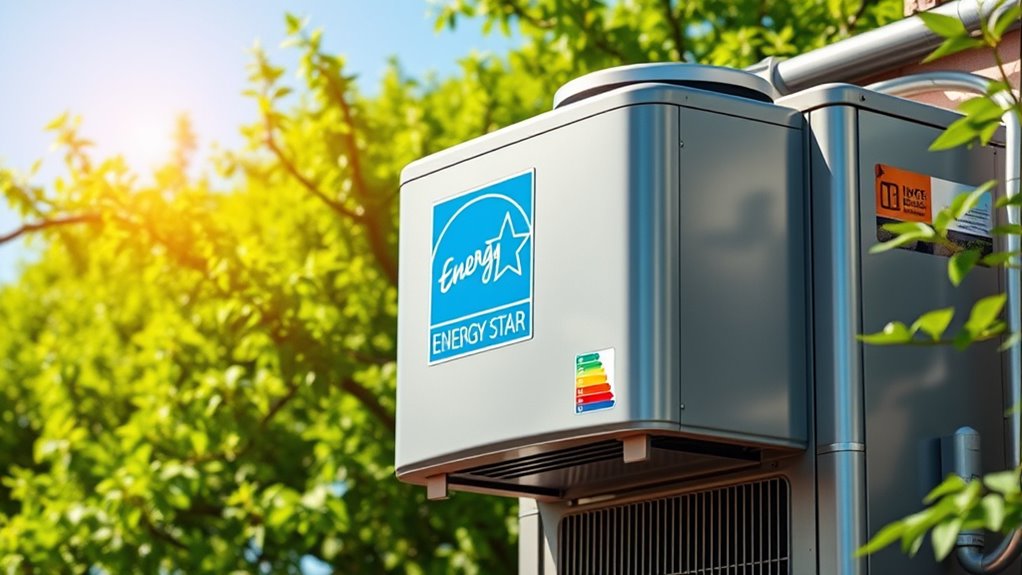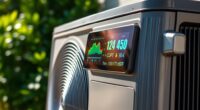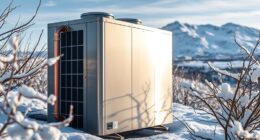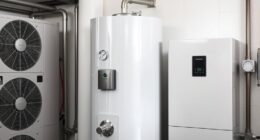Energy Star ratings help you identify heat pumps that are highly efficient, saving energy and reducing your utility bills. They are based on standardized performance metrics like SEER2 for cooling and HSPF2 for heating, ensuring your system works well even in cold weather. Buying an Energy Star-certified unit means you’re choosing a reliable, environmentally responsible model that meets strict quality standards. To discover how these ratings can benefit your home, keep exploring further.
Key Takeaways
- Energy Star ratings for heat pumps indicate high energy efficiency, helping reduce utility bills and environmental impact.
- Ratings such as SEER2 and HSPF2 measure cooling and heating performance, with higher scores signifying better efficiency.
- Certified heat pumps meet strict standards for cold-weather performance and overall energy savings.
- Achieving Energy Star certification can qualify units for rebates and federal tax incentives.
- Ongoing certification ensures heat pumps maintain efficiency standards throughout their lifespan.
Understanding Energy Star Certification Basics
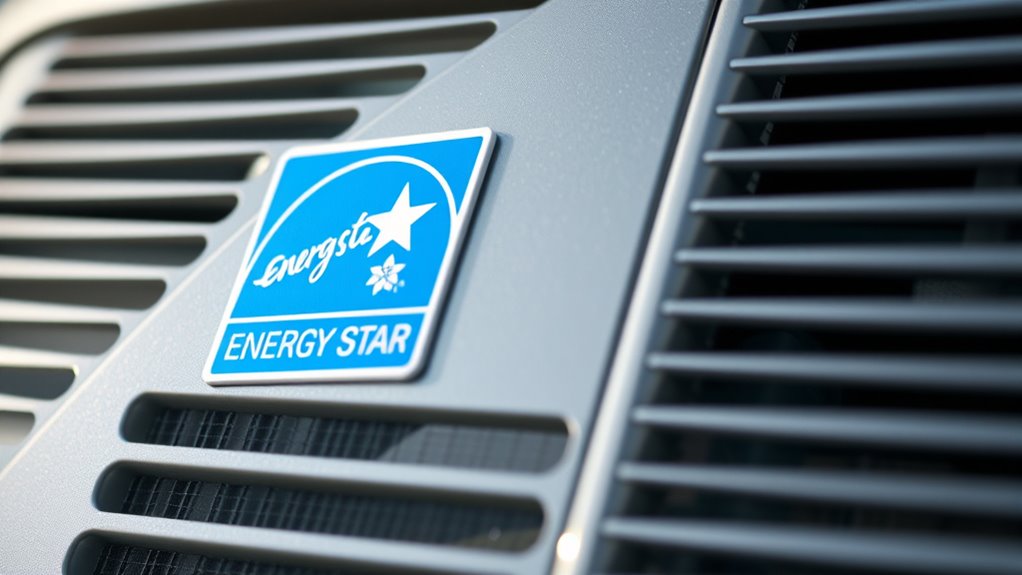
Understanding Energy Star certification basics is essential if you want to make certain that your heat pump or building meets high energy efficiency standards. First, products require third-party validation by EPA-recognized laboratories, ensuring unbiased testing results. For buildings, a score of 75 or higher out of 100 indicates superior energy performance compared to 75% of similar structures. The program covers over 75 product categories, including heat pumps and HVAC systems. Importantly, efficiency gains must not compromise functionality, like heat output. Certification involves benchmarking with EPA’s Portfolio Manager tool, followed by a formal application and verification by licensed professionals—either external verifiers or in-house experts. Maintaining certification requires annual recertification, ensuring ongoing compliance. Energy Star certification is recognized globally as a mark of quality and environmental responsibility, further motivating manufacturers and builders to adhere to stringent standards. Additionally, understanding the testing standards involved can help ensure that the products meet the rigorous criteria set by the EPA. Regular updates to standards ensure that only the most efficient products receive certification, keeping pace with technological advances. Incorporating raw data analysis can also enhance the accuracy of energy performance assessments, leading to more reliable certifications. Staying informed about current regulations helps manufacturers maintain compliance and stay competitive in the marketplace. In addition, understanding organic practices can improve the sustainability of manufacturing processes involved in producing eco-friendly heat pumps.
Key Performance Metrics: SEER2 and HSPF2 Explained
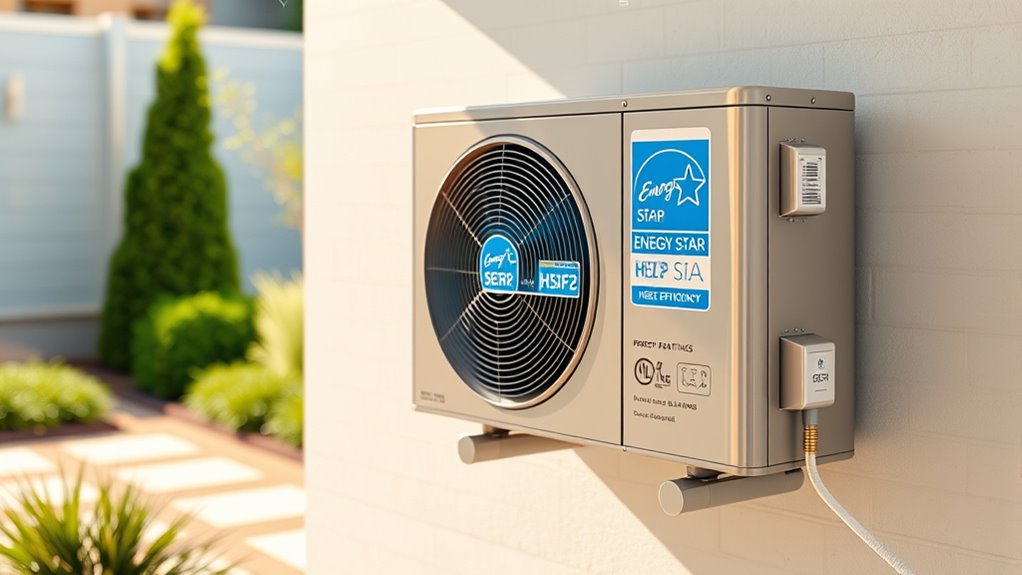
SEER2 and HSPF2 are essential performance metrics that help you gauge a heat pump’s efficiency in cooling and heating modes, respectively. SEER2 measures how well your unit cools over a simulated season, with higher ratings indicating better efficiency and cost savings. The minimum standard is 15.2, but higher ratings can notably lower your energy bills. These ratings reflect real-world performance, which is crucial for making informed purchasing decisions, and are useful for comparing different models to find the most energy-efficient option. Considering system components like the compressor and outdoor coil can further help optimize your system’s performance and longevity. HSPF2 evaluates heating efficiency, comparing total heat output to electric input, with a minimum of 7.5 for split systems. These ratings are designed to reflect real-world performance, with HSPF2 typically about 11% lower than traditional HSPF. Both metrics are vital for comparing models, ensuring you choose an energy-efficient system that saves money and reduces environmental impact over time. Understanding the components of a heat pump, such as the compressor and outdoor coil, can further help optimize your system’s performance and longevity. Additionally, considering merchant services like reliable payment processing can ensure smooth transactions when purchasing or maintaining your heat pump system.
Cold Climate Heat Pump Certification Requirements
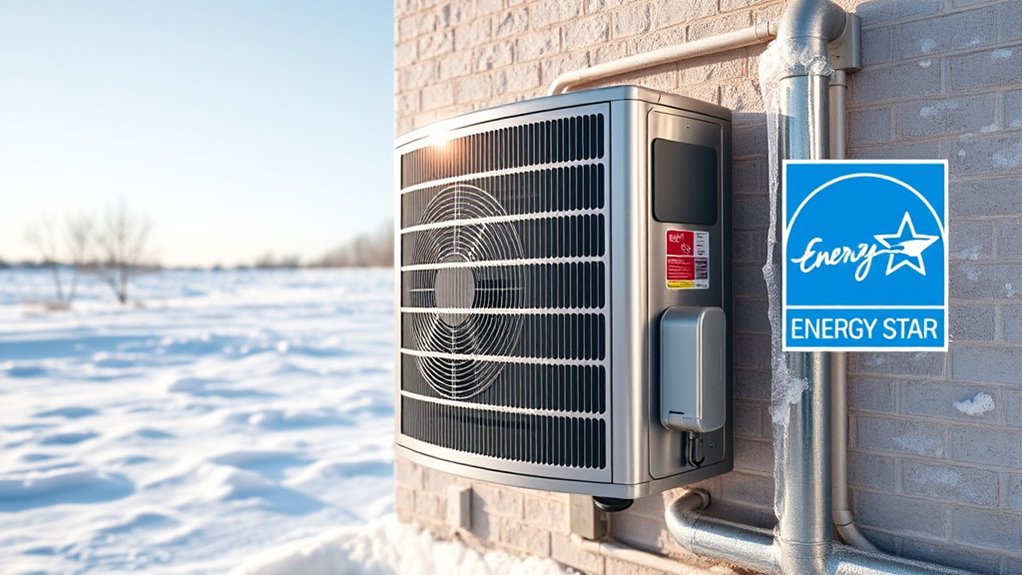
Cold climate heat pumps are designed to perform reliably in low outdoor temperatures, and meeting specific certification standards guarantees they deliver on that promise. Certification bodies like ENERGY STAR, NEEP, and CEE set performance standards to ensure these units operate efficiently in cold conditions. They require systems to meet strict HSPF2, SEER2, and COP ratings, with HSPF2 ≥ 8.5 (ductless) and ≥ 8.1 (ducted), SEER2 ≥ 15.2, and COP ≥ 1.75 at 5°F. These standards also mandate that heat pumps maintain at least 70% of their rated capacity at 47°F. Certification verifies low ambient performance, giving you confidence that the system will heat effectively in winter. Additionally, ENERGY STAR’s rigorous testing and control verification confirm the unit’s reliability in cold weather. The performance standards are designed to ensure consistent operation even during extreme cold conditions. Regional certification standards may vary, but meeting ENERGY STAR criteria ensures a high level of cold-weather performance across various climates.
The 2025 Most Efficient Criteria for Heat Pumps
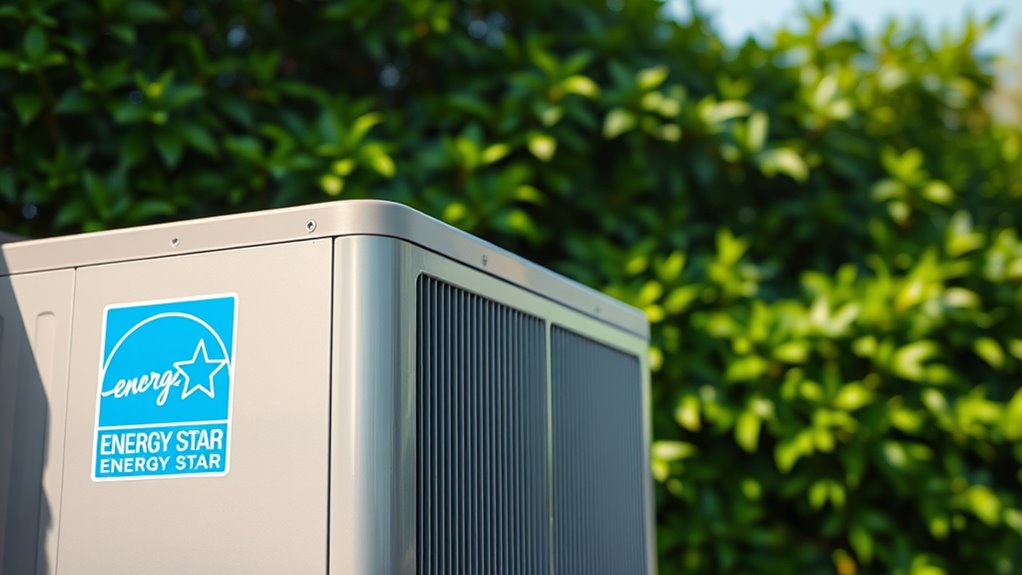
The 2025 Most Efficient Criteria for heat pumps set the benchmark for top-tier energy performance, ensuring that only the most advanced models earn the ENERGY STAR label. To qualify, your heat pump must be listed on the current ENERGY STAR certified models list and meet specific efficiency standards. These include minimum SEER2 and EER2 ratings for cooling, and HSPF2 ratings for heating, which vary by product type and climate. Some models require a COP of at least 1.75 at 5°F. Test methods like Appendix M13 H42 verify performance accuracy. By meeting these criteria, your heat pump delivers superior energy savings, reduces emissions, and can qualify for incentives. The standards are regularly updated, pushing manufacturers toward continuous improvement. Incorporating energy-efficient features can further enhance performance and ensure compliance with upcoming standards. Staying informed about performance testing requirements ensures your system maintains its efficiency and reliability over time. Additionally, understanding maintenance practices can help sustain optimal operation and prolong the lifespan of your heat pump. Moreover, advancements in system controls enable more precise regulation of operation, contributing to higher efficiency and comfort. Keeping abreast of industry innovations can also drive further improvements in heat pump technology and efficiency.
How Energy Star Ratings Impact Your Energy Consumption
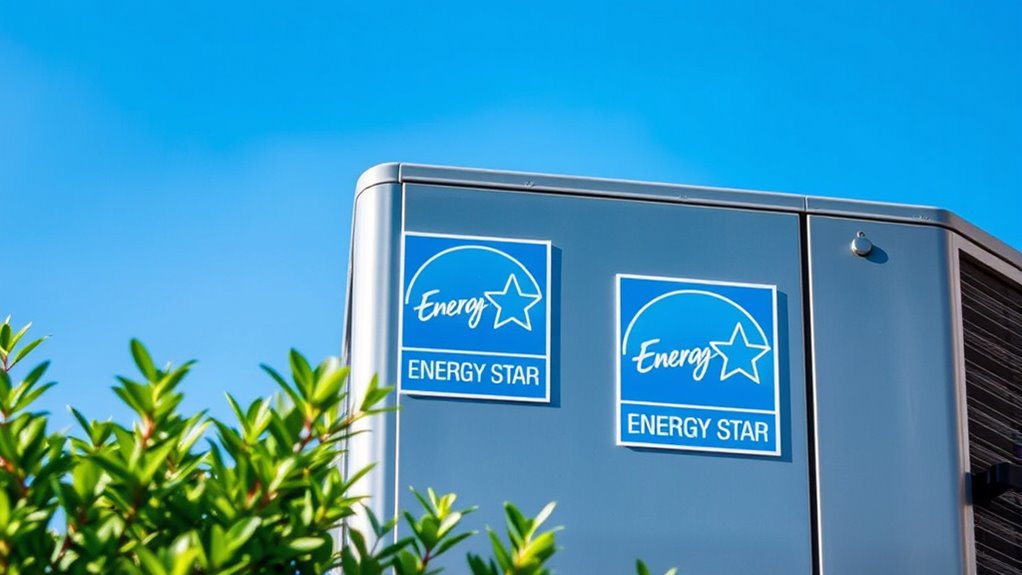
Energy Star ratings directly influence how much energy your heat pump consumes during operation. When you choose an Energy Star certified model, you’re selecting a device designed to meet strict efficiency standards set by the EPA. These models use less energy to perform the same heating or cooling tasks, leading to lower utility bills. Over time, the savings can add up considerably, making these heat pumps a cost-effective choice. Reduced energy consumption means fewer greenhouse gases are emitted, helping protect the environment. By opting for a higher-rated heat pump, you also contribute to broader energy conservation efforts. Energy Star certification ensures that the heat pump maintains its efficiency over its lifespan through ongoing performance standards. Additionally, choosing Energy Star rated appliances supports the development of more sustainable and innovative green technologies. Embracing these standards can also encourage manufacturers to prioritize energy-efficient designs, further benefiting consumers and the environment alike.
Testing Protocols and Compliance Standards

To guarantee heat pumps meet strict efficiency and performance standards, ENERGY STAR employs thorough testing protocols based on ANSI/ASHRAE 118.1-2022 standards. These protocols specify testing conditions such as maintaining the electrical supply at minimum manufacturer voltage and ensuring voltage stability throughout testing. They define precise condenser water temperatures and include preliminary and main test periods to ensure stabilized operation before measurements. Defrost cycle testing is detailed, with clear criteria for initiation and termination, depending on cycle frequency, to reflect real-world performance. Sampling and functional verification protocols confirm installed equipment functions correctly, responds appropriately, and meets performance claims. Environmental conditions are controlled, and test data—covering energy use, heating capacity, and defrost efficiency—must be accurately documented, standardized, and reproducible for certification. Testing protocols ensure consistency and reliability in evaluating heat pump performance, which is crucial for maintaining energy efficiency standards across different models and manufacturers. Additionally, adherence to these standards helps promote industry transparency and consumer trust in certified products. Incorporating quality control measures further ensures the accuracy and integrity of testing results. Implementing regular audits of testing facilities can help sustain the credibility of certification processes and uphold high standards in the industry.
Recognizing High-Performance Heat Pumps in the Market
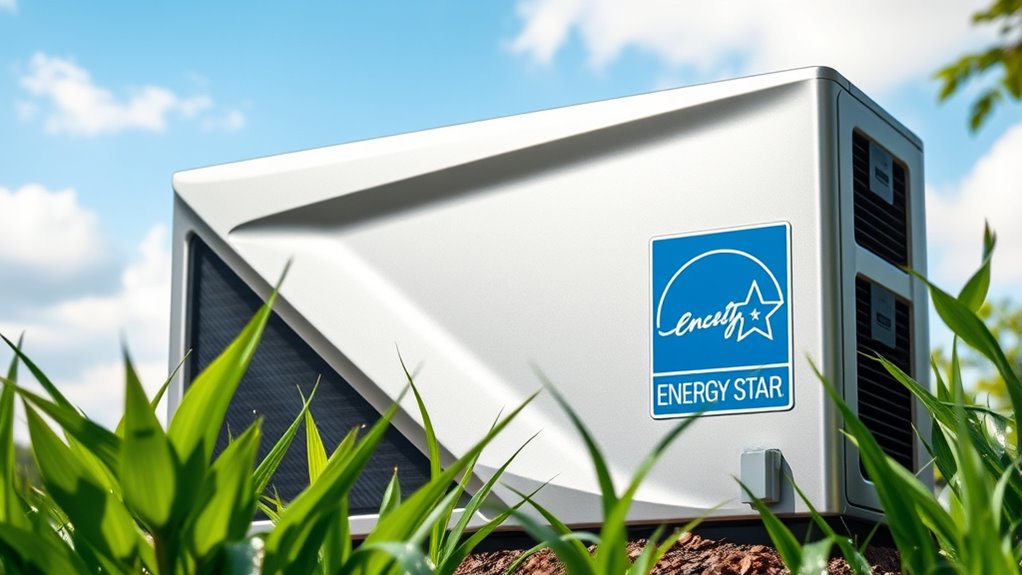
Growing market demand for high-performance heat pumps reflects their increasing importance across diverse industries. To recognize these units, look for key performance indicators like a Seasonal Coefficient of Performance (SCOP) above 3.5, signaling high efficiency. Industrial models often exceed 200 kWth capacity and feature modular designs for scalability, making them suitable for large-scale applications. Certifications beyond Energy Star, such as the EU Ecolabel, are also important markers of quality and environmental responsibility. Advanced units incorporate IoT-enabled predictive maintenance, AI-driven performance optimization, and integration with thermal storage systems. Keep an eye on innovations like high-temperature outputs above 150°C and refrigerant improvements addressing environmental concerns. The global heat pump market is projected to grow at a CAGR of 11.8% during the forecast period, with leading manufacturers like Johnson Controls and Daikin pushing these high-performance features, setting standards in the evolving heat pump market. Additionally, the performance metrics used to evaluate these units are often supplemented by third-party certifications that verify efficiency and environmental standards.
Benefits of Choosing Energy Star Certified Units
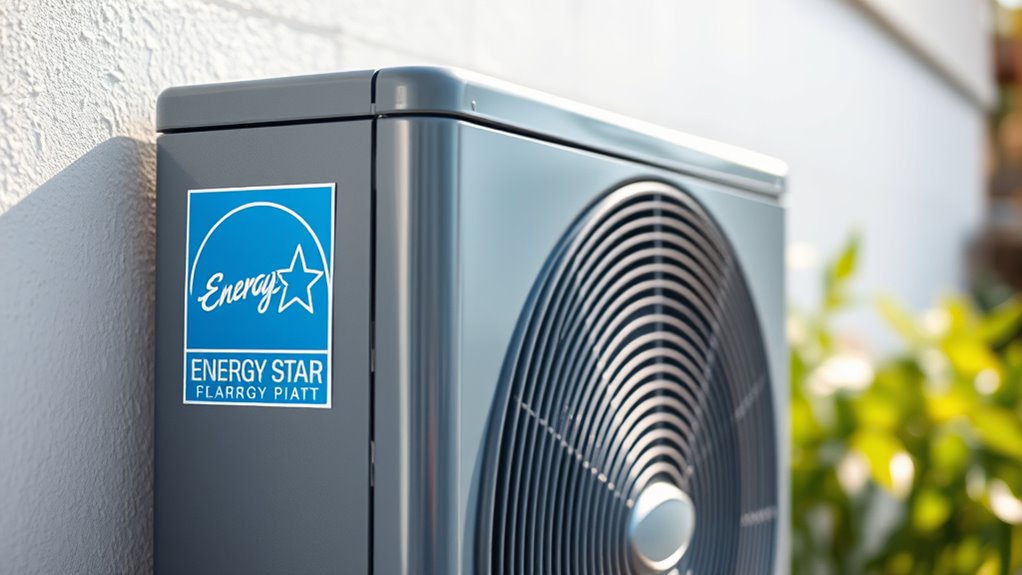
Choosing ENERGY STAR certified heat pumps offers significant savings on your energy bills while providing reliable performance. These units use about half the energy of oil systems and a third of traditional electric heating, drastically reducing your heating costs. They move heat efficiently, delivering up to three times more heat energy than electrical energy consumed, which keeps your home comfortable year-round. ENERGY STAR units also lower cooling expenses due to their high efficiency. Plus, qualifying models may earn federal tax credits up to $2,000, making your upgrade more affordable. Environmentally, these heat pumps cut over 4,500 pounds of greenhouse gases during their lifespan and reduce fossil fuel use by operating on electricity. They’re designed for durability, easy to install, and support broader energy-saving goals.
The Future of Energy Efficiency in Heat Pump Technology

Advancements in heat pump technology are driving remarkable improvements in energy efficiency, making them an increasingly attractive option for both homeowners and industry alike. New designs boost the Coefficient of Performance (COP) by up to 10%, reducing fossil fuel reliance and greenhouse emissions. Integration with renewable energy sources enhances environmental benefits, while innovations like smart technology optimize performance in real-time. Hybrid systems combining heat pumps with traditional heating are becoming more common, offering greater flexibility. The market is growing rapidly, supported by government incentives and a global push for decarbonization. Industrial applications are expanding, with high-temperature heat pumps maturing to meet demanding needs. Overall, ongoing technological progress promises even more efficient, cost-effective, and sustainable heating solutions in the future. Heat pumps extract heat from sources like air, ground, water, or waste heat, which contributes to their high efficiency.
Frequently Asked Questions
How Often Are ENERGY STAR Certifications Reviewed and Updated?
The current question asks how often ENERGY STAR certifications are reviewed and updated. You should know that these certifications aren’t updated on a regular schedule. Instead, reviews happen only when concerns are raised, usually by homeowners or other stakeholders. If issues are found, an independent review is conducted, which can lead to certification withdrawal if standards aren’t met. Updates to standards happen periodically but don’t trigger routine reviews.
Can a Heat Pump Qualify for Both Standard and Cold Climate Recognition?
You can qualify your heat pump for both standard and cold climate recognition if it meets the specific performance criteria for each. This means your unit must pass third-party testing showing at least 45% heating capacity at 5°F for standard certification and at least 70% for cold climate recognition. If your model exceeds 70%, it qualifies for both designations, giving you broader market appeal and recognition.
What Are the Main Benefits of Multi-Stage Heat Pumps?
You gain numerous benefits from multi-stage heat pumps: they provide consistent indoor temperatures by minimizing cycling, reduce noise during low-stage operation, and improve air quality through better humidity control. They also enhance energy efficiency with lower consumption, extend system lifespan by reducing mechanical stress, and guarantee reliable performance in extreme weather. With their ability to match demand precisely, they deliver comfort, savings, durability, and healthier indoor environments.
How Does ENERGY STAR Certification Influence Warranty Coverage?
You might wonder how Energy Star certification impacts warranty coverage. While it highlights product efficiency and reliability, it doesn’t directly change warranty terms. Manufacturers often offer longer warranties to boost confidence, but these are not mandated by the certification itself. So, your warranty depends on the manufacturer’s policies, especially for critical parts like compressors in heat pumps. Overall, Energy Star certification signals quality, but warranty specifics vary by brand.
Are There Regional Differences in ENERGY STAR Certification Requirements?
You might wonder if regional differences affect certification requirements. The truth is, they do, especially in colder areas. For these regions, heat pumps must meet strict cold climate standards, proving they’ll perform well even at 5°F. In milder zones, the requirements focus on general efficiency. So, yes—your location influences certification criteria, ensuring the system works most effectively no matter where you are.
Conclusion
By choosing Energy Star certified heat pumps, you’re planting seeds for a greener future, watching your energy bills shrink like melting snow. These units act as your reliable compass through the cold, guiding you toward efficiency and savings. Imagine your home wrapped in warmth, powered by technology that respects the planet. When you pick a certified heat pump, you’re not just heating your space—you’re fueling a sustainable tomorrow, one energy-efficient step at a time.
